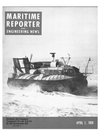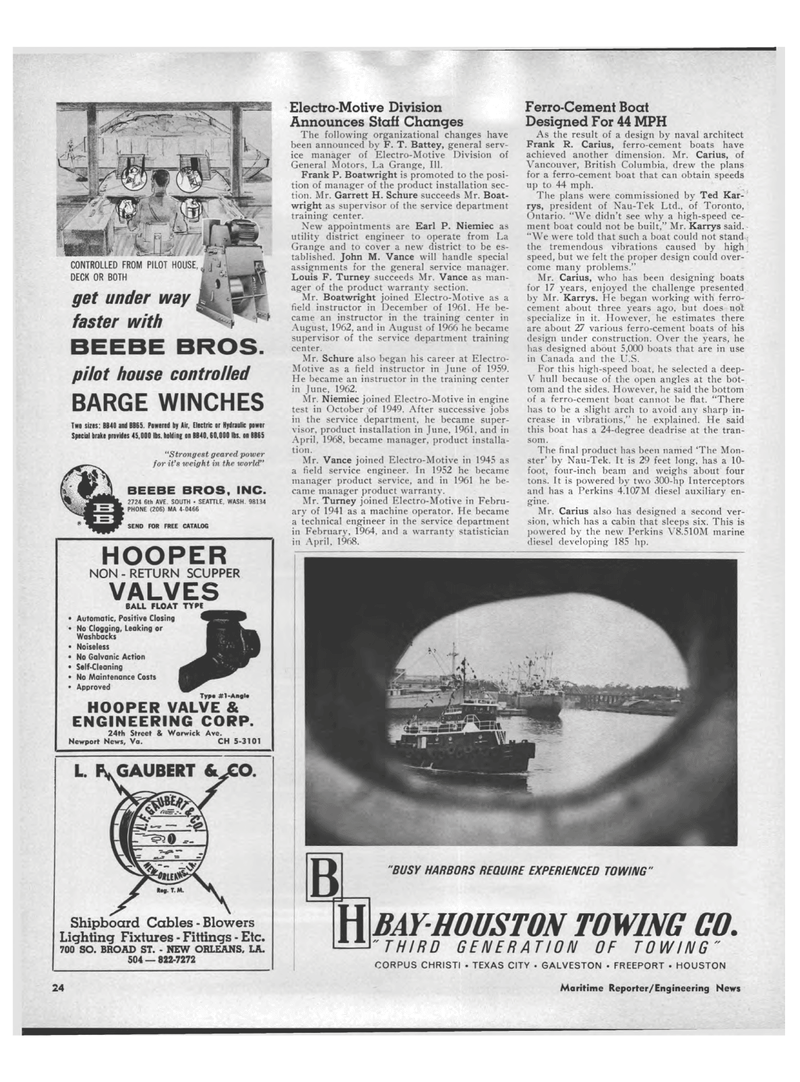
Page 22: of Maritime Reporter Magazine (April 1969)
Read this page in Pdf, Flash or Html5 edition of April 1969 Maritime Reporter Magazine
CONTROLLED FROM PILOT HOUSE, DECK OR BOTH get under way faster with pilot house controlled BARGE WINCHES Two sizes: BB40 and BB65. Powered by Air, Electric or Hydraulic power Special brake provides 45.000 lbs. holding on BB40,60,000 lbs. on BB65 "Strongest geared power for it's weight in the world" BEEBE BROS, INC. 2724 6th AVE. SOUTH ? SEATTLE, WASH. 98134 PHONE (206) MA 4-0466 SEND FOR FREE CATALOG HOOPER NON-RETURN SCUPPER VALVES BALL FLOAT TYPE ? Automatic, Positive Closing ? No Clogging, Leaking or Washbacks ? Noiseless ? No Galvanic Action ? Self-Cleaning ? No Maintenance Costs ? Approved Type #1-Angl. HOOPER VALVE & ENGINEERING CORP. 24th Street & Warwick Ave. Newport News, Va. CH 5-3101 Lighting Fixtures - Fittings - Etc. 700 SO. BROAD ST. - NEW ORLEANS. LA. 504 ? 822-7272 Electro-Motive Division Announces Staff Changes The following organizational changes have been announced by F. T. Battey, general serv-ice manager of Electro-Motive Division of General Motors, La Grange, 111. Frank P. Boatwright is promoted to the posi-tion of manager of the product installation sec-tion. Mr. Garrett H. Schure succeeds Mr. Boat-wright as supervisor of the service department training center. New appointments are Earl P. Niemiec as utility district engineer to operate from La Grange and to cover a new district to be es-tablished. John M. Vance will handle special assignments for the general service manager. Louis F. Turney succeeds Mr. Vance as man-ager of the product warranty section. Mr. Boatwright joined Electro-Motive as a field instructor in December of 1961. He be-came an instructor in the training center in August, 1962, and in August of 1966 he became supervisor of the service department training center. Mr. Schure also began his career at Electro-Motive as a field instructor in June of 1959. He became an instructor in the training center in June, 1962. Mr. Niemiec joined Electro-Motive in engine test in October of 1949. After successive jobs in the service department, he became super-visor. product installation in June, 1961, and in April, 1968, became manager, product installa-tion. Mr. Vance joined Electro-Motive in 1945 as a field service engineer. In 1952 he became manager product service, and in 1961 he be-came manager product warranty. Mr. Turney joined Electro-Motive in Febru-ary of 1941 as a machine operator. He became a technical engineer in the service department in February, 1964, and a warranty statistician in April, 1968. Ferro-Cement Boat Designed For 44 MPH As the result of a design by naval architect Frank R. Carius, ferro-cement boats have achieved another dimension. Mr. Carius, of Vancouver, British Columbia, drew the plans for a ferro-cement boat that can obtain speeds up to 44 mph. The plans were commissioned by Ted Kar-rys, president of Nau-Tek Ltd., of Toronto, Ontario. "We didn't see why a high-speed ce-ment boat could not be built," Mr. Karrys said. "We were told that such a boat could not stand-; the tremendous vibrations caused by high speed, but we felt the proper design could over-come many problems." Mr. Carius, who has been designing boats for 17 years, enjoyed the challenge presented by Mr. Karrys. He began working with ferro-cement about three years ago, but does not specialize in it. However, he estimates there are about 27 various ferro-cement boats of his design under construction. Over the years, he has designed about 5,000 boats that are in use in Canada and the U.S. For this high-speed boat, he selected a deep-V hull because of the open angles at the bot-tom and the sides. However, he said the bottom of a ferro-cement boat cannot be flat. "There has to be a slight arch to avoid any sharp in-crease in vibrations," he explained. He said this boat has a 24-degree deadrise at the tran-som. The final product has been named 'The Mon-ster' by Nau-Tek. It is 29 feet long, has a 10-foot, four-inch beam and weighs about four tons. It is powered by two 300-hp Interceptors and has a Perkins 4.107M diesel auxiliary en-gine. Mr. Carius also has designed a second ver-sion, which has a cabin that sleeps six. This is powered by the new Perkins V8.510M marine diesel developing 185 hp. H "BUSY HARBORS REQUIRE EXPERIENCED TOWII\IG" BAY-HOUSTON TOWING CO, "THIRD GENERATION OF TOWING" CORPUS CHRISTI ? TEXAS CITY . GALVESTON ? FREEPORT . HOUSTON 24 Maritime Reporter/Engineering News

 21
21

 23
23
